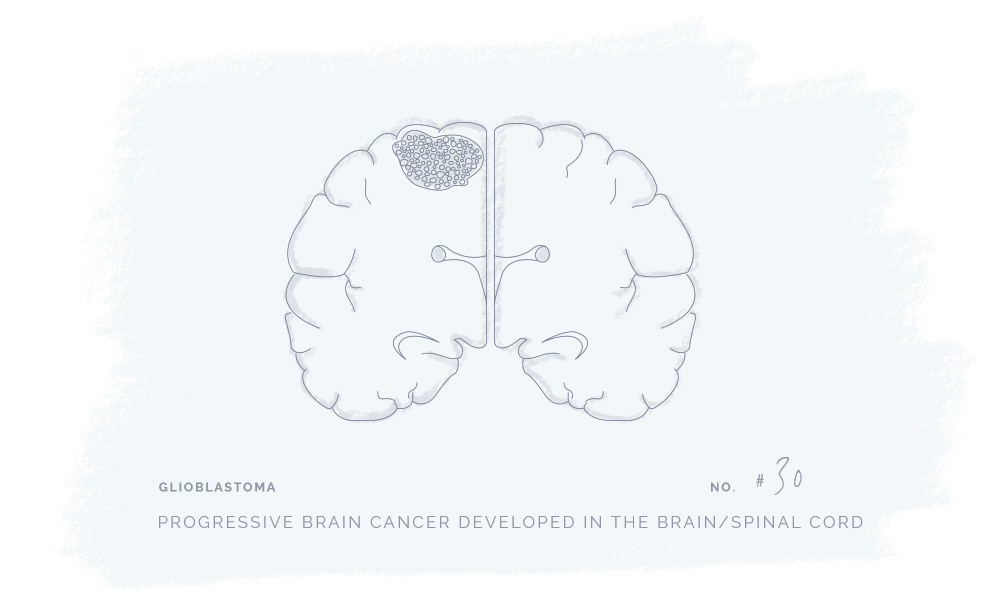Glioblastoma
Category
Cancer
REVIEWED BY
Our Biomedical Scientist
Reviewed based on
Literature Discussion & Clinical Trials
Last update
September 2020

What is glioblastoma
Glioblastoma (GBM) is a highly progressive tumor and type of brain cancer that can develop in the brain or spinal cord. The cancer is highly progressive as the glioblastoma tumors create their own blood supply supporting the growth and have the potential to invade normal brain tissue.1
Symptoms:2
- Frequent and persistent headaches
- Seizures
- Purging
- Double or blurred vision
- Difficulty speaking
- Changes in personality or mood
Cause
The exact cause of glioblastoma is not yet known. However, 3 risk factors have been identified:2
- Age
With age, the risk of developing glioblastoma increases, and most commonly cancer emerges in the age range 45-65-year-old - Exposure to radiation
- Family history of glioblastoma
The connection between Cannabinoids & Glioblastoma
Studies find that CBD and THC may have great therapeutic potential and may be used to help treat Glioblastoma. CBD and THC are well-known cannabinoids, however, they do not have the same psychoactive effects. THC is psychoactive while CBD does not possess psychoactive effects. According to WHO guidelines, the cannabidiol CBD is generally well tolerated with a good safety profile.
Preclinical- and clinical data propose that the cannabinoids THC and CBD may be therapeutic in the treatment of glioblastoma as both In vitro and In vitro studies found cannabinoids to have anti-tumor properties.3
In addition, a recent review found that cannabinoids may reduce tumor growth through suppressing tumor proliferation and angiogenesis and stimulation of tumor cell death.4
The literature discussion is an overview of the published results from scientific studies investigating if and how cannabinoids can be beneficial in the treatment of Glioblastoma. The overview will be updated regularly to ensure the newest and most accurate information.
Link between aggressive tumors and overexpression of CB2
Cannabinoid receptors connected to cell viability are expressed by glial cells.5
Cancer cells overexpress cannabinoid receptors such as CB2 and GPR55 compared to non-cancer glial cells.
There is a correlation between this overexpression and disease prognosis where higher overexpression of CB2 being observed in most aggressive tumors.6,7,8
CBD may exhibit anti-cancer activity
Several glioblastoma studies reported that CBD also exhibited anti-cancer activities.
CBD was shown to exhibit antiproliferative and anti-invasive activities on glioblastoma cells and stimulate differentiation of glioblastoma stem cells (GSCs) and apoptosis process.9,10
In glioma xenografts, tumor growth was reduced by about 20% upon CBD (7.5 mg/kg/day). 7.5 mg/kg/day of THC showed similar effects and combined administration of THC and CBD decreased tumor growth to a higher extent.11
In human glioblastoma cell lines, cancer cell viability and proliferation were reduced by CBD.12
CBD was also found to be involved in ameliorating the effectiveness of other anti-cancer drugs like temozolomide, carmustine, or doxorubicin via TRPV-2.13</sup
Clinical trials are research studies that examine new treatments and evaluate their effects on human health outcomes.
Cannabinoid receptors are safe and possibly beneficial in tumor-shrinking
A pilot clinical study (pilot phase I trial) included nine patients with recurrent glioblastoma to evaluate cannabinoid antitumoral action. It was found that cannabinoid delivery is safe and exhibits promising tumor-shrinking effects. Larger scale clinical studies are needed to assess the real anti-cancer effects of cannabinoids in patients suffering from glioblastoma.14
- https://www.webmd.com/cancer/brain-cancer/what-is-glioblastoma#1
- https://www.mayoclinic.org/diseases-conditions/glioma/symptoms-causes/syc-20350251
- https://ghmedical.com/endocannabinoid-system/diseases/glioblastoma
- Dumitru, C.A., (2018). ” Cannabinoids in Glioblastoma Therapy: New Applications for Old Drugs”: https://www.ncbi.nlm.nih.gov/pmc/articles/PMC5964193/
- Stella, N., (2010). “Cannabinoid and cannabinoid-like receptors in microglia, astrocytes, and astrocytomas. Glia 58, 1017–1030”. https://pubmed.ncbi.nlm.nih.gov/20468046/
- Calatozzolo, C., Et al., (2007). ” Expression of cannabinoid receptors and neurotrophins in human gliomas. Neurol. Sci. Off. J. Ital. Neurol. Soc. Ital. Soc. Clin. Neurophysiol. 28, 304–310”. https://pubmed.ncbi.nlm.nih.gov/18175076/
- Ellert-Miklaszewska, A., Et al., (2007). ”Distinctive pattern of cannabinoid receptor type II (CB2) expression in adult and pediatric brain tumors. Brain Res. 1137, 161–169”. https://pubmed.ncbi.nlm.nih.gov/17239827/
- Sánchez, C., et al., (2001). ”Inhibition of glioma growth in vivo by selective activation of the CB(2) cannabinoid receptor. cancer Res. 61, 5784–5789”. https://pubmed.ncbi.nlm.nih.gov/11479216/
- Hernán Pérez de la Ossa, D., Et al., (2013). ”Local delivery of cannabinoid-loaded microparticles inhibits tumor growth in a murine xenograft model of glioblastoma multiforme. PloS One 8, e54795”. https://pubmed.ncbi.nlm.nih.gov/23349970/
- Nabissi, M., Et al., (2015). ”Cannabidiol stimulates Aml-1a-dependent glial differentiation and inhibits glioma stem-like cells proliferation by inducing autophagy in a TRPV2-dependent manner. Int. J. cancer J. Int. cancer 137, 1855–1869”. https://pubmed.ncbi.nlm.nih.gov/25903924/
- Torres, L., Et al., (2011). ”A combined preclinical therapy of cannabinoids and temozolomide against glioma. Mol. cancer Ther. 10, 90–103”. https://pubmed.ncbi.nlm.nih.gov/21220494/
- Deng, L., Et al., (2016). ”Quantitative analyses of synergistic responses between cannabidiol and DNA-damaging agents on the proliferation and viability of glioblastoma and neural progenitor cells in culture. J. Pharmacol. Exp. Ther”. https://www.ncbi.nlm.nih.gov/pmc/articles/PMC5193074/
- Nabissi, M., Et al., (2013). “Triggering of the TRPV2channel by cannabidiol sensitizes glioblastoma cells to cytotoxic chemotherapeutic agents. Carcinogenesis 34, 48–57”. https://pubmed.ncbi.nlm.nih.gov/23079154/
clinical trials - Guzmán, M., Et al., (2006). ”A pilot clinical study of Delta9-tetrahydrocannabinol in patients with recurrent glioblastoma multiforme. Br. J. cancer 95, 197–203”. https://pubmed.ncbi.nlm.nih.gov/16804518/
CANNABINOIDS & RECEPTORS
Below you find the plant cannabinoids, cannabinoid receptors, and endocannabinoids that are associated with the potential therapy.
If you have any further information relevant to the connection between Glioblastoma and cannabinoids or find any of the information inaccurate, outdated or incomplete please contact us here.

